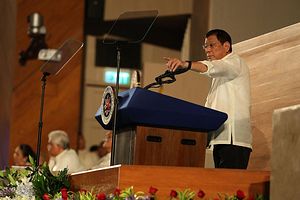The Philippine police has released some statistics confirming the extensive reach of the government’s “war on drugs.”
Dubbed as “Project Double Barrel Alpha,” the anti-drug campaign is a top priority of the administration of President Rodrigo Duterte, who assumed power last July 1.
According to the information bulletin released by the police, the government has conducted 40,982 anti-drug operations from July 1 last year to January 7 this year. The police killed 2,206 drug personalities during this period while 44,070 were arrested.
The police also visited 6,097,672 houses as part of its “Project Tokhang,” which involves police officers going around communities across the country in order to persuade suspected drug users to submit themselves to a drug rehabilitation program.
The police reported too that 1,020,244 people surrendered to authorities in the past six months. More than 940,000 of those who surrendered are drug users while about 75,000 are pushers.
The police also acknowledged that 4,049 suspected drug personalities were victims of vigilante-style killings. This is the most controversial feature of the anti-drug campaign, which is described by human rights groups as a clear case of unabated extrajudicial killings involving state forces. The police, however, blamed the surge of violence on the purging activities of rival drug cartels.
The police revealed that 35 of its members and three soldiers were killed during the anti-drug operations in the past six months.
Presidential Communications Secretary Martin Andanar cited the statistics of the “war on drugs” as proof that the government strategy is working.
“It is evident we are hitting the mark in our campaign against illegal drugs. But more than the statistics, the real score in the government’s intensified anti-drug operations is that it has pulled down the country’s crime rate by 32 percent,” Andanar pointed out.
General Ronald dela Rosa, chief of the national police, boasted that the anti-drug campaign has saved many innocent lives.
“Before, when you’re talking about murder, it’s people who are innocent. They are victims of drug-crazed people who committed crimes. Now most of those killed are drug personalities. That’s the very big difference,” he said in a media interview.
The casualties of the “war on drugs” could be higher because there are unreported drug-related cases, but even government statistics are already sufficient to understand the bloody impact of Duterte’s crusade to end the drug menace in the country.
Duterte’s supporters might interpret the statistics as affirmation of the president’s political will and strong leadership. But critics can use the same data to highlight the violent consequences of Duterte’s obsession to solve the drug crisis in less than a year.
The president himself admitted that several innocent civilians, including children, were killed by the police in some of the anti-drug operations. He apologized to the public but at the same time he insisted that the campaign will continue until the end of his term.
“Until the last pusher is out of the street, I’ll be very frank with you, until the last drug lord is killed, this campaign will continue until the very last day of my term,” he said during a media interview.
Could this mean more deaths, arrests, police visits, and extrajudicial killings until 2022? Fighting illegal drugs and criminality deserves public support but how can the people approve the killing of innocent children? How can justice prevail if impunity involving state forces is elevated as a de facto doctrine of the government?

































